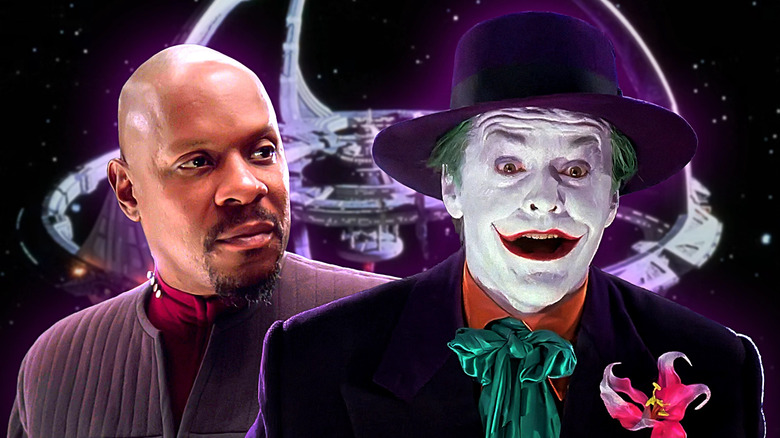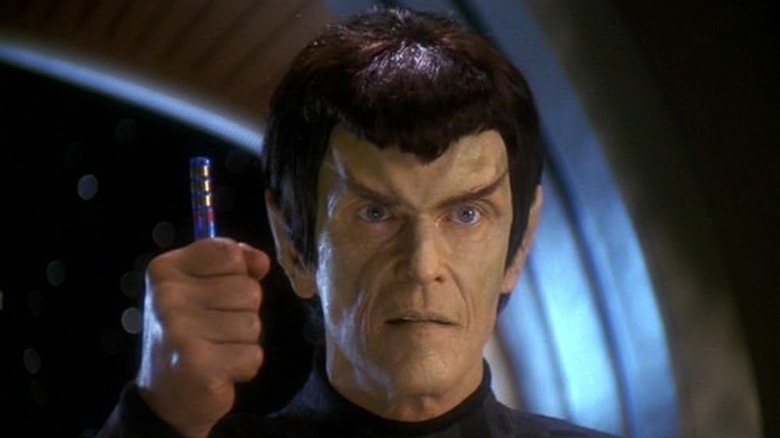One Of The Best Star Trek Episodes Ever Got Its Title From Tim Burton's Batman
We may receive a commission on purchases made from links.
"Star Trek: Deep Space Nine" doesn't quite have the cultural cache of "The Original Series" or "The Next Generation," but don't think it's lesser because of that. Many Trekkies, including at least one person at /Film, have argued that "DS9" is the very finest "Star Trek" of them all.
"Deep Space Nine" was set on the titular space station, orbiting the formerly occupied planet Bajor. This singular setting wasn't the only way that "DS9" broke up the "Trek" formula; many of the show's episodes got darker than "Trek" usually does. The last two seasons featured a serialized narrative about Starfleet fighting a war against the invading Dominion. "DS9" took "Star Trek" into darkness first (and more successfully) before J.J. Abrams did so.
The episode "Duet" explored the scars left on Bajor by its Cardassian occupiers. Bajoran Major Kira Nerys (Nana Visitor) comes face to face with a man who appears to be Cardassian war criminal Gul Darhe'el (Harris Yulin, who got so invested he pushed for an audacious rewrite). "Duet" stages a compelling two-man show between Visitor and Yulin, and a morality play about guilt and forgiveness.
The other "DS9" episode commonly praised for going dark is season 6's "In The Pale Moonlight," when Captain Ben Sisko (Avery Brooks) crosses some serious ethical boundaries to get the Romulans into the Dominion War. The episode's script, with a story credit by Peter Allan Fields and originally written by Michael Taylor, featured revisions from Ronald D. Moore (who loves Shakespearean drama in "Star Trek"). The title "In The Pale Moonlight" even comes from Moore. Where did Moore get it? It turns out he snagged it from Tim Burton's 1989 "Batman" film, specifically a question asked by the Joker (Jack Nicholson): "Ever dance with the Devil in the pale moonlight?"
In "Batman," the Joker poses this question as a taunt to Bruce Wayne (Michael Keaton), who he doesn't know is Batman. "I always ask that of all my prey," the Joker explains. "I just like the sound of it." But there is a deeper meaning to the phrase, specifically about letting go of morality (like the Joker does) and in doing so, "dancing with the Devil."
On Deep Space Nine, Star Trek danced with the Devil in the pale moonlight
Those nine words also suggest seduction, which is fitting because the Joker isn't only out to kill Batman and make Gotham City into his playground — he also wants to win the heart of Vicki Vale (Kim Basinger). In the third act of "Batman," the Joker leads Vicki in a ballroom dance in the deserted top floor of a cathedral. After that, Vickie can say that she has danced with the devil in the pale moonlight. So, too, can Ben Sisko.
Ronald D. Moore was interviewed for the 2021 documentary "The Center Seat: 55 Years of Star Trek," and his work on "In The Pale Moonlight" came up. (As a testament to the episode's fame, the episode of the doc focused on "Deep Space Nine" is even called "Dancing with Syndication in the Pale Moonlight.")
According to Moore, he's the one who came up with the framing device where Sisko records an audio log about what he did. That anchors the episode around Sisko, specifically him grappling with the compromises he made and whether he can live with them. The whole point of the episode is that Sisko reluctantly danced with the Devil; he didn't enjoy doing it, but if it results in victory, he can live with it. The episode's conclusion about moral compromises is why it's still a controversial story for some "Star Trek" fans, yet just as many claim it proves Ben Sisko is the best "Star Trek" captain out there.
In earlier drafts, the episode had been known as "Patriot." When Moore renamed it, he knew the phrase "ever dance with the Devil in the pale moonlight?" appeared in "Batman." But he didn't realize the movie was the saying's original source. As he recalled in his "Center Seat" interview:
"When I wrote that title, I was under the impression that that was just a saying. And everybody kept coming up to me and saying, 'Oh, so this is a 'Batman' reference?' And I said, 'No, it's not about Batman, it's just about the phrase, about the saying, 'Dance with the Devil in the pale moonlight'... [I] later came to find that it's not really a phrase, it's really just something that was said in 'Batman.'"
The cultural legacy of Tim Burton's "Batman" is long and wide, but I don't think anyone working on the movie expected what a huge (if indirect) impact the movie would have on "Star Trek."

